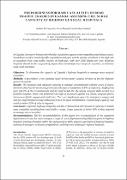| dc.contributor.author | Onyachi, Nathan W. | |
| dc.contributor.author | Bakaitwoha, Everd Maniple | |
| dc.contributor.author | Santini, Stefano | |
| dc.date.accessioned | 2019-11-01T16:41:25Z | |
| dc.date.available | 2019-11-01T16:41:25Z | |
| dc.date.issued | 2011-04-01 | |
| dc.identifier.citation | Onyachia, N.W., Bakaitwoha, E. M., and Santini, S., 2011. Preparedness for mass casualties of road traffic crashes in Uganda: assessing the surge capacity of highway general hospitals. health policy and development, 9(1), pp. 17-26. | en_US |
| dc.identifier.uri | http://hdl.handle.net/20.500.12280/2439 | |
| dc.description.abstract | In Uganda, increase in human and vehicular populations against a non-expanding road infrastructure, breakdown in enforcement of traffic regulations and poor vehicle quality contribute to the high rate of casualties from road traffic crashes on highways, with over 2000 deaths per year. Highway hospitals should be the vanguard of preparedness to manage mass surgical casualties, to minimize road crash mortality.
Objectives: To determine the capacity of Uganda’s highway hospitals to manage mass surgical casualties.
Methods: A descriptive, cross-sectional study of emergency surgical services of ten key highway general hospitals.
Results: The hospitals had adequate capacity to manage uncomplicated solitary cases of injury. However, they had severe shortage of essential surgical equipment (9.6% of expected). Staffing was poor (64.3% of the recommended) and the staff lacked the life-saving surgical skills needed in a frontline hospital. There was perennial shortage of essential supplies e.g. blood, surgical gloves, intravenous fluids, oxygen and medicines. There was inadequate space for emergency surgery and only few staff members reside within easy reach for quick mobilization. Overall surge capacity was rated at below 50% of what is required.
Conclusion: Ugandan highway hospitals lack the technical and infrastructural capacity to handle mass casualties resulting from road traffic crashes. Surge capacity is below 50% of that required to manage mass casualties.
Recommendations: The key recommendations of this paper are: re-organisation of the outpatient departments to cater for mass emergency surgical cases, deployment of qualified surgeons in highway hospitals, training of hospital staff in life-saving surgical skills, targeted supervision of highway hospitals, training of managers in disaster preparedness, and improved funding for highway hospitals. | en_US |
| dc.language.iso | en | en_US |
| dc.publisher | Uganda Martyrs University Press | en_US |
| dc.relation.ispartofseries | health policy and development;volume 9 number 1 | |
| dc.subject | Casualities | en_US |
| dc.subject | Road traffic crashes | en_US |
| dc.subject | Surge capacity | en_US |
| dc.subject | Highway hospitals | en_US |
| dc.title | Preparedness for mass casualties of road traffic crashes in Uganda: | en_US |
| dc.title.alternative | assessing the surge capacity of highway general hospitals | en_US |
| dc.type | Article | en_US |


